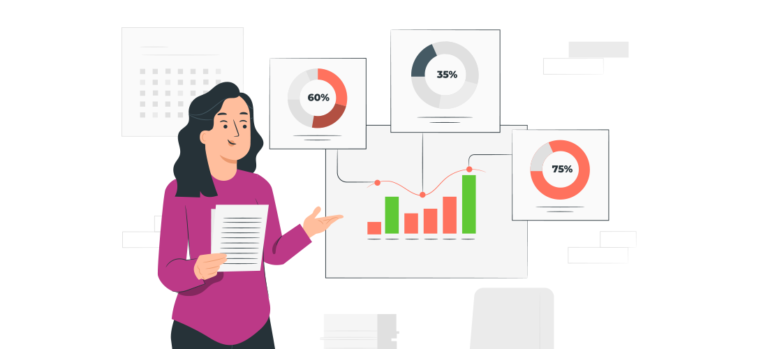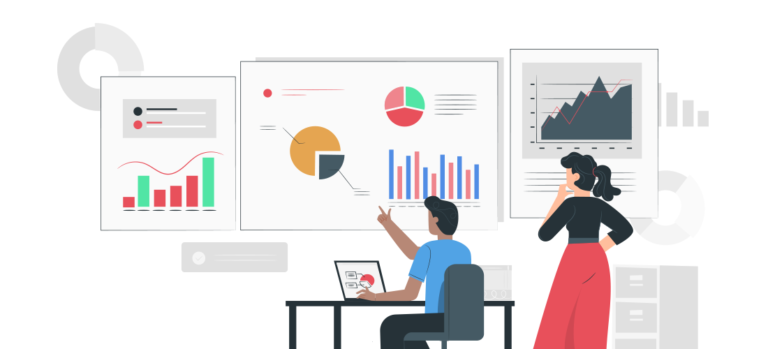Why does your firm need the persuasive power of Supply Chain Analytics? Read to learn more.
The fiery impact of e-commerce on traditional retailers is just a part of the data-driven revolution sweeping the definition of business functions today. And about the same, supply chain management is an integral part of an organization to gain insight and extract values from the explosive data inventory to define and manage their supply chains. Supply chain analytics is just an essential part of supply chain management.
What is Supply Chain Analytics?
While the concept of the supply chain process has existed for quite a bit, the traditional approach to supply chain analysis has evolved significantly. Supply chain analytics is a process that uses data and quantitative methods to upgrade the decision-making process across the supply chain.
Supply chain planning critically affects a company’s ability to provide a positive consumer experience and account for overall profitability. Supply chain analytics primarily analyses data and information drawn from several applications associated with an industrial supply chain.
Supply Chain Analytics for Reducing Overall Costs and Improving Margins

Supply chain analytics focuses primarily on pointing out the most efficient and effective way to procure, roll out industrial products, and ensure customer satisfaction at the same time. Increased profit margins are the direct result of an optimized supply chain performance.
By clearly stating consumer demands and needs, supply chain analytics provides a systematic approach for updating and improving industrial performance, with reduced costs, minimized issues, and a profit increase.
How does Supply Chain Analytics work in reducing costs?
Supply chain analysis brings out the root cause, establishes a starting base, and helps in framing a goal for optimal efficiency. Supply chain analytics works as follows:
Identify the cost-effective workflow inefficiencies
Any supply chain management process is heavily stuffed with hidden expenses, including manufacturing, order volumes, frequency, logistics, etc. Supply chain analysis helps uncover the high hidden costs directly from the manufacturing warehouse.
Forecast supply demands
Supply chain analysis allows the industry to have a healthy sales forecasting to ensure the product stock. Forecasting presents one of the critical supply chain improvement factors. Analyzing previous sales, trends, present market conditions, and new competitors helps to get the chain going seamlessly without procuring something that the industry cannot provide.
Setting up a Supply Chain Network
Direct investment in all of the steps in a supply chain process adds costs and increases the probability of damage and errors. Designing a flexible supply chain network or transforming the existing network is proven efficient in high returns with low investment.
Diversify carrier modes
A reliable and affordable carrier service isn’t an easy find, and failing to diversify carrier relationships can result in a sudden halt if the company goes out of business. Thus, having options over more than one carrier service can provide more comprehensive control over the supply chain.
Pay for the proper transportation
Transportation service is one of the main pillars of supply chain success. In the time of ‘same-day delivery, businesses often strive to meet consumer demands.
Though most of the consumer pool is empathetic towards resources and extensive locations, having an exemplary shipping service can usually cut the tension and thus reduce the transportation cost by a large number.
Outsourcing Supply Chain operation
Outsourcing is an excellent technique to improve performance while cutting costs within the supply chain. With expensive aspects like transportation and warehousing, an outsourced partner can add more skill and efficiency to the company in performing the service. Benefits? Rapid access to services and resources on demand, more flexibility, and variable cost structure for cost-effective growth, without any direct investment.
Evaluation of assets for increasing productivity
The simple yet most efficient way to improve supply chain performance is to evaluate the assets and identify the areas for improvement to reduce superfluous costs. Increased utilization will keep the supply chain running smoothly and save the company from a waste of investment.
Types of Supply Chain Analytics

To help supply chain organizations to adapt and evolve in an ever-changing industry, Gartner’s model proposes five types of supply chain analytics:
- Descriptive Analytics
- Predictive Analytics
- Prescriptive Analytics
- Diagnostic Analytics
- Cognitive Analytics
Descriptive Analytics
Descriptive Analytics is typically based on past reports, and this culls insights from data inventory to understand data and trends better. Based on the past data, descriptive analytics help keep track of day-to-day operations. The information for descriptive analytics can come from both internal and external systems of the supply chain process.
Descriptive Analytics is primarily used to chalk out accurate databases when processed statistically, which in turn provides visibility for both the system in the supply chain.
Predictive Analytics
As the name suggests, predictive analytics primarily manifests as various demand forecasts. Predictive analytics helps a company to predict the possibility of multiple factors affecting different business scenarios. The data and statistics in predictive analytics provide early insights for production management and material procurement to meet the consumer demand pool.
Predictive Analytics uses descriptive analytics as a foundation to add more capability to detect and estimate specific outcomes and allows the industry to react accordingly.
Prescriptive Analytics
Perspective analytics combines descriptive and predictive analytics, providing specific recommendations to reach the desired goal. Prescriptive analytics recommends strategies aimed at maximizing inventory system performance.
By bringing optimization capacity to predictive analytics, prescriptive analytics suggests the best choices for future values. However, the complex structure of prescriptive analytics demands robust software structures for data process and interpretation.
Diagnostic Analytics
Diagnostic Analytics uses in-depth data mining and data interpretation for correlated analytics. Using diagnostic analytics, you can discover anomalies in the data to better understand events. Diagnostic analytics differs from the other four types of analytics due to its independent nature. It has the ability to isolate specific events within a supply chain management process to solve underlying questions for a better impact.
Cognitive Analytics
Cognitive Analytics brings in a futuristic humane approach to data analysis. It is an emerging technology focused on human thinking and behavior to draw out essential contexts to interpret results. It primarily relies on digital cognitive technologies and specific methods, including data correlation, machine learning, contextual awareness, and semantic relationships. Cognitive Analytics helps businesses extract deep insights from data and effectively turn the information into actionable modules.
Applying Cognitive Analytics to accelerate supply chain performance

Cognitive Analytics allows the industries to understand and leverage different types of supply chain analytics. This Analytics works on replicating human thinking and behavior to better understand complex, complicated situations. In supply chain networks, cognitive analytics is used with advanced technologies like Robotic Process Automation (RPA) and Artificial intelligence (AI).
With exception-based issue resolution, cognitive analytics transition requires change at every step to impact operating models, skill sets, and digital tools. This cutting-edge supply chain analytics lets industries establish workable structures to foster greater productivity and customer satisfaction. Cognitive Analytics promises long-term operational success in supply chain management.
Supply Chain Analytics: Why does it matter?
Supply chain analytics works on data from all the supply chain touch points. The importance of supply chain analytics lies in helping the industries make more profound, better, informed, and faster decisions about their business operations. Detailed data analysis results in easy identification of potential risks in a company. It helps reshape the modern supply chains with a better insight into planning, optimizing the inventory, product distribution, customer satisfaction, and beyond.
For instance, analytics software can flag potential risks for a specific logistics provider in delivering delayed shipments for at least two months. The software can pick up the delayed pattern and record the possibility of the pattern continuation. Results? The logistics provider can quantify the impact and rectify the delayed pattern.
Supply chain analytics improves industrial planning with more information and accurate forecasts. This enables the company to fix the operational places to meet the expected volume and customer expectations. Any slight deviation at any part of the supply chain negatively impacts the process with a potential customer loss. With supply chain analytics, companies can increase the effectiveness and optimize the efficiency of their supply chain network.
History of Supply Chain Analytics

Rooting back to 1911, supply chain analytics was first introduced to the world in the work of Fredrick Taylor, ‘The Principles of Scientific Management’. Taylor essentially laid the framework for the modern fields of industrial engineering and supply chain management. Analytics were somewhat limited to statistical analytics, helping organizations predict demand and measure business success. Later on, Henry Ford adapted and optimized the Fredrick Taylor technique to create a modern assembly line to support more production.
IBM researcher Hans Peter Luhn is the mastermind behind ‘business intelligence’ and developed the foundation for different types of data analytics in supply chain management in 1958. However, a few years later, eminent personalities like Bud Lalonde, Stafford Beer, and others began exploring new ideas in organizing business information. By 1980, the structured hierarchy for organizing, planning, and executing viable systems gained popularity as supply chain management.
With the introduction of the internet in the 1990s, a revolutionary new feature in supply chain management was brought in by British technologist Kevin Ashton when he accidentally hit upon a radio frequency identification sensor to capture data automatically about the movement of products across the supply chain.
Later on, with the advent of cloud computing, the cloud-based platforms acted as a foundation for unifying and orchestrating data to multiple sources. And ensuring an easy collaboration among the supply chain management partners. The global emergence of data allowed organizations to analyze data from different sources and refine supply chain analytics. The massive bandwidth of data also made it easier to implement advanced structures on various platforms.
In recent years, supply chain analytics emerged as a more powerful tool with advanced technology and software to improve business automation and increase supply chain analytics.
Role of Supply Chain Analytics
Supply chain analytics is efficient at every step in uncovering opportunities for improvement in the process. Some actionable roles played by supply chain analytics are:
Identify the root cause
Supply chain analytics helps in understanding the problems related to inventory, suppliers, product quality, etc to define the direction of improvement.
Defining data sources
Data can be procured from both inside and outside the organization. Supply chain analytics helps in monitoring multiple metrics for a detailed understanding of a company’s performance.
Analyze Data for improvement
The next step after defining the data is to assess the data for business development. Supply chain analytics works with data sets from multiple sources and creates a data-based strategy for improving the overall performance.
Culture improvement
A data-driven culture encourages a wide data sharing window for distinctive data-based decisions for all levels of the industry. Comprehensive knowledge of how a supply chain analysis work, provide due access to data, and empower the employees to accelerate operational decisions using analytics data.
Develop a business-specific analytics platform
Supply chain analytics creates a unique customized data structure t to meet supply chain management needs. They also help conduct real-time analytics to ensure a quick response to possible changes. Business-specific analytics provides accurate forecasts that eventually lead to overall growth.
Features of Supply Chain Analytics
Supply chain analytics works at a deeper level to procure improvement from the core point. But is the supply chain analytics worth the profile to look into for solutions?
Features of supply chain analytics include:
Data visualization and connection
The core element of supply chain analytics is the data. Thus the solution needs to have access to every possible source of information. Identifying data from multiple sources like IoT, software, applications, or third-party data, provides a better insight into the situation.
Collaboration
A single stream of data is irrelevant when it comes to data analytics. Thus, every step of the supply chain management adds to its own value in supply chain analytics. Businesses in collaboration with supply chain management partners like manufacturers, suppliers, logistic partners, and even consumers are more successful in enhancing their services. Mutually beneficial ideas and information make it easier to improve.
Comprehensive Analysis
Supply chain analytics provides extensive and in-depth information and observations for a complete structure. As a result, the solution possesses extensive functionality with immediate results.
Cognitive Involvement
Pertaining to the recent technological developments, supply chain analytics are sure to take a huge role in the coming years. Cognitive Involvement helps the companies understand the root cause of disruption and prioritize their course of action in response. And such a solution is only bound to become more effective and efficient in the coming years.
Future trends of Supply Chain Analytics

Supply chain analytics is the future of e-commerce. And it will continue to evolve with the advancement of data structures, analytics models, and infrastructure. Supply chain analytics is expected to lead more realistically and comprehensively to more independent supply chains. For greater visibility of the supply chain, analytics is likely to be the most valuable tool.
Prescriptive and Cognitive Analytics still remain unattainable for smaller organizations due to limited human and capital resources, it is expected to emerge as an attainable tool for the mid-market segment. In years to come, supply chain analytics are expected to evolve larger as companies continue to grow digitally.
Some of the other sectors where supply chain analytics can play a major role include:
- Blockchain
- Hyper Automation
- Graph Analytics
- Artificial Intelligence
- Internet of Things (IoT)
- Sustainable Automation
What is big supply chain analytics?

Big supply chain analytics uses data in a quantitative aptitude to improve decision-making in a supply chain. Supply chain analytics generates big data and extensive supply chain analytics turn the data into insights. Big supply chain analytics differs in two ways:
- It makes way for the database beyond traditional data, in Enterprise Resource Planning (ERP) and Supply Chain Management (SCM) systems.
- It applies in-depth and powerful statistical methods to all the data sources present.
Following the additional methods, big supply chain analytics creates new insights to help Supply Chain decisions making.
Acquiring smoother logistics with supply chain analytics
Supply chain analytics is the most effective solution for enhancing supply chain management. But how can one use it correctly to reap the best benefits? Here is some expert guidance to put supply chain analytics to best use:
- Turn data and information into operational insights – The ever-changing supply chains lead to a large pool of information, often stored in unorganized and diverse databases. And outsourcing has added to the data complexity. As a result, one may find it extremely difficult to search and make use of the data.
Supply chain analytics brings together the data in a structured format, prioritizing the data involvement. This helps in easy accessibility and strategizing for a quick response. - Identifying crucial areas to center supply chain analytics – The key to progress in the right direction is to maximize the operational efficiency of the right analytics. Supply chain analytics focuses on arranging the algorithm to create an analytical and operational structure. This helps in bringing flexibility and a customer-centric approach to improve fulfillment.
- Using real-time data to deal with disruptions – With the ever-increasing productivity and demands, the size and complexity of the supply chain are growing globally. With the ever-changing data structure, analysis and decision-making are often hampered due to irrelevant and outdated databases with the ever-changing data structure.
Supply chain analytics helps navigate a real-time concurrent system to manage and optimize the demand pool. Real-time data analytics helps control the fluctuations throughout the process, ensuring a smoother transition.
What supply chain analytics can do to your business?
Supply chain analytics helps identify new opportunities within the existing supply chain network to gain a profitable insight with reduced cost and improving demand satisfaction.
Supply chain analytics helps a business in the following ways:
Increase Sales
Supply chain analytics uncovers underlying reasons for slow stocks due to incorrect estimates. A business can boost its sales in no time with correct forecasts and accurate forecasts to meet the demand pool.
Improve Business standard operational measures
Supply chain analytics transforms ERP system raw data into structural metrics for better understanding and insights. This helps the industry to identify the loopholes and act accordingly to rectify the crisis.
Effective and efficient data utilization
Supply chain analytics is an advanced strategy resulting in inaccurate measurements to improve overall supply chain performance.
Eliminate redundancies
Allocating the proper resources to improve supply chain efficiency can enhance the speed of operations. Supply chain analytics reduces the pressure of traditional workflow and replaces it with technical solutions for improved customer services.
Supply Chain Analytics: The Best Way to Upscale Your Business Game!
With the advancement of complex technologies, machine learning, artificial intelligence, and streaming analytics have heavily revolutionized the manufacturing niche. Supply chain analytics is how the industries draw structural insights for supply chain management to transform and optimize the supply chain. Supply chain analytics assists companies in developing an intelligent, positive, and customer-centric improved supply chain to meet the demands.
Opt for the best way possible to scale up your business. Reap the best profits with increased customer satisfaction at a reduced cost.
FAQs
Supply chain analytics is the process used by industries to extract value from a large data pool and gain comprehensive insight to improve performance, procurement, processing, and distribution of goods.
Basic tools used in supply chain analytics include:
- Supply chain software tools
- Demand forecasting tools
- Supplier management tools
- Shipping and logistics tools
- Compliance tools
With the ever-increasing demand pool and extreme pressure on supply chain operations, companies often struggle to meet the expectations. Supply chain analytics helps businesses to digress from their traditional workflow and adapt scientific techniques to improve and accommodate the ever-changing dynamic market.
Top companies operating in supply chain analytics in the world include:
- International Business Machines Corporation (IBM)
- Accenture PLC
- Oracle Corporation
- SAP SE
- Capgemini SE





